Studies of ROV concepts 2022 - Part A

Date of publication: 2022
Authors:
Xiong Wu, Du Jiang, Juntong Yun, Xin Liu, Ying Sun, Bo
Tao, Xiliang Tong, Manman Xu, Jianyi Kong, Ying Liu,
Guojun Zhao, & Zifan Fang.
Autonomous Underwater Vehicles are often subject to
many interferences, which cause poor control stability
while performing their tasks. In this paper, a decoupling
control algorithm is proposed, and a single control
volume/single attitude angle model is constructed for the
coupling in the control system of the attitude of six
degrees of freedom Autonomous Underwater Vehicle…
etc…


Authors:
Thanh Le Xuan, Tuan Phan Anh, Duong Tran Khanh,
Dong Nguyen, & Tung Pham Xuan.
This paper presents research and development on
communication and control for Remotely Operated
Underwater Vehicles (ROV). For communication and
control of the ROV from a Ground Control Station
(GCS) on a mothership or land, a lightweight messaging
protocol for communicating with ROV based on
developing MAVLink has been used. The communication
and control system of the ROV from a GCS includes two
steps: Communication between the ROV and a float is
conducted via electrical cable, & communication between
the float and a GCS on mothership or land via wireless
technology.




Date of publication: 2022
Authors:
Adnan Elahi Khan Khalil, Shahzad Anwar, Ghassan
Husnain. Atif Elahi, & Zhang Dong.
Underwater search and tracing is a complex engineering
problem due to various factors, such as unpredicted
oceanic environment, poor communications, underwater
navigations. Therefore, an autonomous underwater
vehicle (AUV) cooperation is needed to accomplish
challenging missions. This study focuses on searching and
tracing an underwater target based on an improved
cooperative path planning model.



Date of publication: 2022
Authors:
Pedro Daniel de Cerqueira Gava, Cairo Lúcio Nascimento
Júnior, Juan R. B. F. Silva, & Geraldo José Adabo.
This article presents an Unmanned Underwater Vehicle
simulator named Simu2VITA 1, designed to be rapid to set
up, easy to use, and simple to modify the vehicle’s
parameters.



Authors:
Mingyue Cheng, Quansheng Guan, Fei Ji, Julian
Cheng, & Yankun Chen
Marine science and Internet of underwater things
applications rely significantly on collecting data from
underwater sensors. Data collection using long-distance
underwater acoustic communications consumes a lot of
energy in underwater sensor nodes, which are powered
by batteries. To achieve low-energy consumption, we can
use the autonomous underwater vehicle (AUV) to move
close to sensor nodes and exploit the short-range and
high-rate communications.



Authors:
Naifeng Wen, Lingling Zhao, Ru-Bo Zhang, Shuai Wang,
Guanqun Liu, Junwei Wu, and Liyuan Wang.
The unstructured, dynamic marine environmental
information and the cooperative obstacle avoidance
problem significantly challenge the online path planner
for unmanned surface vehicles. Efficiency and
optimization are crucial for online path planning schemes.
For this reason, the authors proposed an algorithmic
combination of the optimal rapidly exploring random tree
and artificial potential field methods.



Authors:
Josep Bosch, Pere Ridao, Rafael Garcia and Nuno Gracias
Omnidirectional cameras underwater enable many
new and exciting applications in multiple fields.
Among them, Remotely Operated Underwater
Vehicles (ROVs) will be piloted directly using the
images captured by omnidirectional cameras through
virtual reality (VR) headsets. This immersive experience
will extend the pilot’s spatial awareness and reduce the
usual orientation problems during missions.
This paper presents this concept and illustrates it with
the first experiments for achieving this purpose.



Authors:
Lin Zhao, Mingxi Zhou, Brice Loose, Virginia Cousens,
Raymond Turrisi
An affordable Remotely Operated Vehicle (ROV) has
been modified for under-ice sensing. This paper presents
the system upgrade, including sensor integration,
electronics, and navigation stack.
The new ROV is equipped with a Doppler Velocity Log
(DVL), an attitude heading reference system (AHRS)
for navigation, a stereo camera, and a forward-looking
imaging sonar for perception.



Author: Gokhan Atal
This article focuses on passive self-management of the
umbilical of a Remotely Operated Vehicle (ROV) for
underwater exploration. The goal is to give a predictable
shape to the umbilical, using moving ballasts and buoys to
stretch the umbilical to avoid entanglement of the cable
itself or with surrounding obstacles. The ballasts and buoys
move to maintain the cable taut without a motorized
system. A model of the umbilical is proposed. The
presence of waves, as well as the cases with and without
currents, are considered. Three configurations of the
umbilical are offered, each to be the most adapted to ROV
exploration missions: near the surface, sea exploration,
and diving in the presence of significant obstacles.



Author: Christophe Viel.
This article focuses on passive self-management of the
umbilical of a Remotely Operated Vehicle (ROV) for
underwater exploration. The goal is to give a predictable
shape to the umbilical, using moving ballasts and buoys to
stretch the umbilical to avoid entanglement of the cable
itself or with surrounding obstacles. The ballasts and buoys
move to maintain the cable taut without a motorized
system. A model of the umbilical is proposed. The
presence of waves, as well as the cases with and without
currents, are considered. Three configurations of the
umbilical are offered, each to be the most adapted to
ROV exploration missions: near the surface, sea
exploration, and diving in the presence of significant
obstacles.



Author: Bolun Huang and Qi Yang
The open-frame structure of work-class ROVs results in
significant model uncertainties, and its motion is strongly
disturbed by the umbilical cable. To address these
problems, this article developed a nonlinear disturbance
observer-based super-twisting double-loop sliding-mode
control (NDO-STDSMC) method to achieve trajectory
tracking control of work-class ROVs with system
uncertainties and external disturbances.



Authors:
Teresa Ramos, Antonio Córdoba, Amalia Luque, and
Ana de las Heras
This paper provides a methodological proposal for the
design and development process of a remotely operated
vehicle (ROV). The design core and product design
specifications (PDS) of Pugh’s Total Design model are
considered, focusing on the early stages of the product
design and development process.



Authors:
Waseem Akram, Alessandro Casavola, Nadir Kapetanovi,
and Nikola Miškovic
Aquaculture net pens inspection and monitoring are
essential to ensure net stability and fish health in the fish
farms. Based on the fact that Remotely operated vehicles
(ROVs) offer a low-cost and sophisticated solution for the
regular inspection of the underwater fish net pens, the
authors discuss the integration of an ROV for regular
inspection and tracking of nets.



Authors: Zhiwei Yu, Kai Li, Yu Ji, Simon X. Yang
In the last few years, there have been many new
developments and significant accomplishments in the
research of bionic robot fishes. However, in terms of
swimming performance, existing bionic robot fishes
lag far behind fish, prompting researchers to constantly
develop innovative designs of various bionic robot fishes.
In this paper, the latest designs of robot fishes are
presented in detail, distinguished by the propulsion mode.



Authors: Shijun Shen, Chaofan Wang, Zhiqiang Qiu,
Zhiwu Ke, and Dawei Gong
An autonomous underwater vehicle (AUV) can only
carry limited energy for improved flexibility. In this study, a
multi-energy acquisition model is established to manage
the AUV’s energy, which includes a heart rate sampling
system, a mixed-energy circuit topology, and a maximum
power output algorithm of environmental energy based
on power trajectory tracking..



Authors: Zuhayr Rymansaib, Benjamin Thomas, Alfred
Anthony Treloar, Benjamin Metcalfe, Peter
Wilson, Alan Hunter.
Underwater crime scene investigation and emergency
response are tasks typically carried out by divers
constituting part of a specialist team. Operating in such
dynamic environments, often with poor visibility and
risk of concealed hazards, can be time-consuming and
dangerous. Autonomous uncrewed vessels with
underwater acoustic imaging sensors have been used for
similar purposes in other fields (e.g., hydrography, naval
mine countermeasures, etc.). Still, they have not been
adopted in this specific application domain.



Authors: Ri Lin, Yucheng Zhao, Dejun Li, Mingwei Lin,
and Canjun Yang.
This paper proposes an underwater electromagnetic
guidance method based on the magnetic dipole model to
address the poor effect of optical/visual guidance used in
AUV terminal docking with strong background light and
turbid water quality.








Authors:
Jielun Fang, Yanfeng Zhuang, Kailang Liu, Zhuo Chen,
Zhou Liu, Tiantian Kong, Jianhong Xu, and Cheng Qi
Research field of soft robotics is developing exponentially,
as it opens up many possibilities, such as human-
interactive robots, wearable robots, and transformable
robots in unpredictable environments.
Wet environments, such as the sea and in vivo, represent
dynamic and unstructured environments where adaptive
soft robots can reach their full potential. Recent progress in
soft hybridized robotics performing tasks underwater
heralds a diversity of interactive soft robotics in wet
environments. This document reviews the development of
soft robots in wet environments.



Authors:
Angela Mazzeo, Jacopo Aguzzi, Marcello Calisti,
Simonepietro Canese, Fabrizio Vecchi, Sergio Stefanni, and
Marco Controzzi
The collection of delicate deep-sea specimens of biological
interest with remotely operated vehicle (ROV) industrial
grippers and tools is a lengthy and costly procedure.
Industrial grippers were originally designed for heavy
manipulation tasks, whereas sampling specimens requires
dexterity and precision.
The document describes the grippers and tools commonly
used in underwater sampling for scientific purposes,
systematically reviews the state of the art of research in
underwater gripping technologies, and identifies design
trends.



Authors: Samuel M. Youssef, MennaAllah,, Mahmood
A. Saleh, Mostafa A. Mousa, Mahmoud
Elsamanty, and Ahmed G. Radwan
As rigid systems become increasingly limited in their
capabilities to perform complex tasks and adapt to their
environment, like living creatures, the need for soft systems
has become more prominent due to the similar complex,
compliant, and flexible characteristics they share with
intelligent natural systems. This review provides an
overview of the recent developments in the soft robotics,
with a focus on the underwater applications.



Authors:
Samuel M. Youssef, MennaAllah,, Mahmood A. Saleh,
Mostafa A. Mousa, Mahmoud Elsamanty, and
Ahmed G. Radwan
As rigid systems become increasingly limited in their
capabilities to perform complex tasks and adapt to their
environment, like living creatures, the need for soft
systems has become more prominent due to the similar
complex, compliant, and flexible characteristics they share
with intelligent natural systems. This review provides an
overview of the recent developments in the soft robotics,
with a focus on the underwater applications.

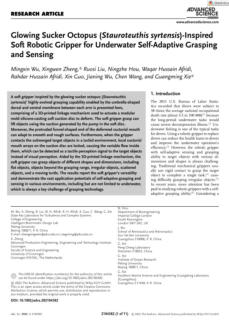

Authors:
Lei Li, Siqi Wang, Yiyuan Zhang, Shanyuan Song, Chuqian
Wang, Shaochang Tan, Wei Zhao, Gang Wang,
Wenguang Sun, Fuqiang Yang, Jiaqi Liu, Bohan Chen ,
Haoyuan Xu, Pham Nguyen, Mirko Kovac, Li Wen
Many real-world applications for robots, such as long-
term aerial and underwater observation, cross-medium
operations, and marine life surveys, require robots with
the ability to move between the air-water boundary. This
study describes an aerial-aquatic hitchhiking robot that is
self-contained for flying, swimming, and attaching to
surfaces in both air and water, and that can seamlessly
move.



Authors:
Zhong Shen, Hua Zhong, Erchao Xu, Runzhi Zhang, Ki
Chun Yip, Lawrence Long Chan, Leo Lai Chan, Jia
Pan, Wenping Wang, and Zheng Wang
This study proposes a novel approach to underwater
manipulator design and control, exploiting the
characteristics of soft robots with a hybrid structure for
improved rigidity and force output.



Authors:
Bo Huang, Zhongyan Liu, Yujing Xu, Qiaochu Ding,
Guanjie You, Mengchun Pan, Jiafei Hu, Qi Zhang
The frequent pitching motion of underwater vehicles
during the mission will produce a more complex
hydrodynamic wake, which is important for detecting
and tracking underwater vehicles. In this paper, a
numerical method is presented to simulate the wakefield
during the pitching motion of an underwater vehicle by
combining the dynamic overset grid method.

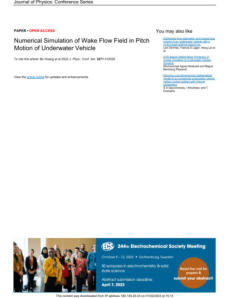

Authors: Rafsan Al Shafatul Islam Subad, Md Mahmud
Hasan Saikot, and Kihan Park
Tactile information is crucial for recognizing physical
interactions, manipulating objects, and planning motion
for a robotic gripper. However, current tactile technologies
have certain limitations, particularly directional force
sensing. In particular, they are expensive, difficult to
fabricate, and mostly unsuitable for underwater use. This
study presents a cost-effective synthesis technique for a
flexible, multi-directional force-sensing system.

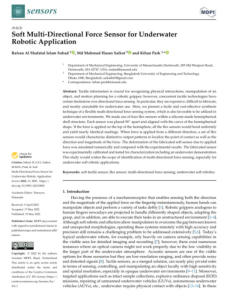

Authors: Sander C. Van den Berg, Rob B.N. Scharff,
Zoltán Rusák, Jun Wu
This document presents “OpenFish”, an open-source
soft robotic fish optimized for speed and efficiency. It
uses a combination of an active and passive tail segment
to accurately mimic the thunniform swimming mode.
Through the implementation of a novel propulsion system
that is capable of achieving higher oscillation frequencies
with a more sinusoidal waveform. It reaches a top speed
of 0.85 m/s and outperforms the previously reported
fastest soft robotic fish by 27%.



Authors:
Boai Sun, Weikun Li, Zhangyuan Wang, Yunpeng Zhu,
Qu He, Xinyan Guan, Guangmin Dai, Dehan Yuan, Ang
Li, Weicheng Cui, and Dixia Fan
Bio-inspired fish robots have the advantages of high
efficiency, high maneuverability, low noise, and minor
fluid disturbance. Therefore, they have gained increasing
research interest, which has led to a great deal of
remarkable progress, theoretically and practically, in recent
years. This review highlights the authors’ enhanced
scientific understanding of bio-inspired propulsion and
sensing underwater and then presents the research
progress and performance characteristics of different bio-
inspired robot fish classified by the propulsion method.





Click on the
octopus to return to
the top of the page

Authors:
Vishnu Kandimalla, Matt Richard, Frank Smith, Jean
Quirion, Luis Torgo, and Chris Whidden
The Ocean Aware project, supported by Innovasea and
Canada's Ocean Supercluster, is developing a new
method to monitor fish without tagging them. The system
employs sensors like acoustic devices, sonar, and cameras
in place of conventional tracking methods, which are
unsuitable for endangered fish. This technology will help
scientists study and monitor these fish more effectively,
particularly in areas such as fish passages or energy sites.



Authors:
Andre Jesus, Claudio Zito, Claudio Tortorici, Eloy Roura,
Giulia De Masi
This paper reviews the problem of object detection in
underwater environments. The authors analyze and
quantify the limitations of conventional state-of-the-art
(SOTA) algorithms in computer vision when applied to this
challenging environment. They also provide insights and
general guidelines for future research



Authors:
Sara Aldhaheri, Giulia De Masi, `Eric Pairet, Paola Ardon
This paper discusses previous research and the limiting
factors that affect the long-held prospects of autonomous
underwater manipulation. It then highlights research
directions that have the potential to improve the
autonomy capabilities of Intervention Autonomous
Underwater Vehicles (I-AUVs).

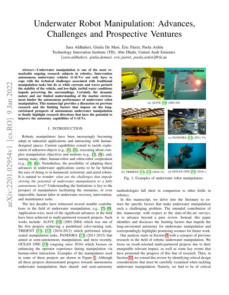

Authors:
Kai Hu, Chenghang Weng, Yanwen Zhang, Junlan Jin,
and Qingfeng Xia
This paper discusses why underwater images are often of
low quality and how this impacts the ability of the ability to
recognize objects. It explains the degradation of image
quality and the use of deep learning technology to
improve it. The paper also explores other methods to
enhance underwater video, typical datasets, and ways to
measure image/video quality. Lastly, it looks at future
improvements in underwater imaging.

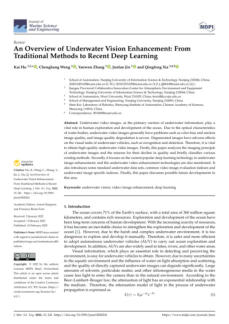

Authors:
Jiachen Yang, Meng Xi, Jiabao Wen, Yang Li, Houbing
Herbert Song
Underwater gliders are popular, and figuring out their
routes is crucial. The ocean is challenging because it's
constantly changing, making planning a good route
difficult. Traditional methods are ineffective because
they're inflexible. The authors propose a new system to
enhance the intelligence of these underwater vehicles
regarding their routes.

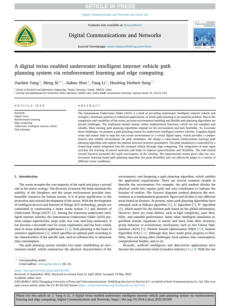

Authors:
Nahuel Garcia-d’Urso, alejandro Galan-Cuenca, Paula
Pérez-Sánchez, Pau Climent-Pérez, andres Fuster-Guillo,
Jorge azorin-Lopez, Marcelo Saval-Calvo, Juan Eduardo
Guillén-Nieto, & Gabriel Soler-Capdepón
This paper presents a dataset of images of fish trays from a
local wholesale fish market. It contains pixel-wise (mask)
labeled specimens, along with species information and
various size measurements.





Authors:
Angela Mazzeo, Jacopo Aguzzi, Marcello Calisti,
Simonepietro Canese, Michela Angiolillo, A. Louise Allcock,
Fabrizio Vecchi, Sergio Stefanni, and Marco Controzzi
This study aims to improve scientific sampling procedures
in marine environments by developing a gripping system
or control strategy, outlining the process of gathering data
from researchers and ROV operators to understand
current sampling procedures and identify the
requirements for new end-effectors. It emphasizes the
need for a versatile system capable of handling the
challenges posed by the deep-sea environment.



Authors: Shay Osler, and Timothy Sands
This article discusses advancements in the control of
unmanned ocean vehicles, specifically focusing on the
application of deterministic artificial intelligence (DAI) for
improving the heading control of a simulated remotely
operated underwater vehicle (ROV). It highlights the shift
from classical methods of trajectory tracking using
negative feedback to newer methods involving DAI,
which combines optimal learning with self-awareness
through a governing mathematical model.

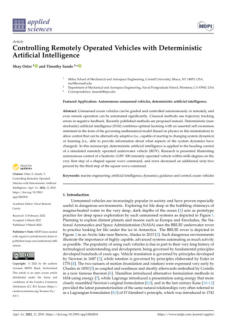

Authors:
Carlos A. Zuluaga, Luis M. Aristizábal, Santiago Rúa, Diego
A. Franco, Dorie A. Osorio, and Rafael E. Vásquez
This paper intends to describe the development process
and methodology for creating a modular software
architecture for a remotely operated vehicle (ROV) using
systems engineering principles, outlining a basic model of
traditional systems engineering to define stakeholder
interactions and development baselines. The paper also
discusses the integration of software architecture with
hardware using the actor model and details the
implementation of object-oriented programming for class
structure.



Authors:
Zhiguo Zhou, Xinxin Hu, Zeming Li, Zhao Jing, and
Chong Qu
This study proposes a new fusion algorithm for detecting
and tracking unmanned surface vehicles (USVs),
highlighting the challenges faced by current algorithms in
accurately detecting and tracking USVs due to factors like
small target size and environmental interference. It then
introduces the proposed solution, which involves a fusion
algorithm that combines detection and tracking
techniques to improve accuracy and reduce issues like
missed detection and tracking drift. It also mentions the
creation of datasets to test the algorithm and claims that
the fusion algorithm shows superior performance
compared to using detection or tracking algorithms alone.













